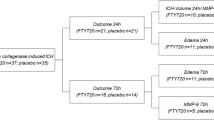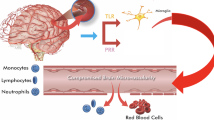Abstract
Intracerebral hemorrhage (ICH) leads to high rates of death and disability. The pronounced inflammatory reactions that rapidly follow ICH contribute to disease progression. Our recent clinical trial demonstrated that oral administration of an immune modulator fingolimod restrained secondary injury derived from initial hematoma, but the mechanisms remain unknown. In this study, we aim to investigate the effects of fingolimod on inflammatory mediators and vascular permeability in the clinical trial of oral fingolimod for intracerebral hemorrhage (ICH). The results showed that fingolimod decreased the numbers of circulating CD4+ T, CD8+ T, CD19+ B, NK, and NKT cells and they recovered quickly after the drug was stopped. The plasma ICAM level was decreased and IL-10 was increased by fingolimod. Interestingly, fingolimod protected vascular permeability as indicated by a decreased plasma level of MMP9 and the reduced rT1%. In conclusion, modulation of systemic inflammation by fingolimod demonstrates that it is an effective therapeutic agent for ICH. Fingolimod may prevent perihematomal edema enlargement by protecting vascular permeability.
Similar content being viewed by others
References
Qureshi AI, Mendelow AD, Hanley DF. Intracerebral haemorrhage. Lancet 2009, 373: 1632–1644.
Ribo M, Grotta JC. Latest advances in intracerebral hemorrhage. Curr Neurol Neurosci Rep 2006, 6: 17–22.
van Asch CJ, Luitse MJ, Rinkel GJ, van der Tweel I, Algra A, Klijn CJ. Incidence, case fatality, and functional outcome of intracerebral haemorrhage over time, according to age, sex, and ethnic origin: a systematic review and meta-analysis. Lancet Neurol 2010, 9: 167–176.
Qureshi AI, Tuhrim S, Broderick JP, Batjer HH, Hondo H, Hanley DF. Spontaneous intracerebral hemorrhage. N Engl J Med 2001, 344: 1450–1460.
Wang J. Preclinical and clinical research on inflammation after intracerebral hemorrhage. Prog Neurobiol 2010, 92: 463–477.
Mracsko E, Veltkamp R. Neuroinflammation after intracerebral hemorrhage. Front Cell Neurosci 2014, 8: 388.
Keep RF, Hua Y, Xi G. Intracerebral haemorrhage: mechanisms of injury and therapeutic targets. Lancet Neurol 2012, 11: 720–731.
Fu Y, Hao J, Zhang N, Ren L, Sun N, Li YJ, et al. Fingolimod for the treatment of intracerebral hemorrhage: a 2-arm proofof- concept study. JAMA Neurol 2014, 71: 1092–1101.
Kim JY, Kawabori M, Yenari MA. Innate inflammatory responses in stroke: mechanisms and potential therapeutic targets. Curr Med Chem 2014, 21: 2076–2097.
Zhou Y, Wang Y, Wang J, Anne Stetler R, Yang QW. Inflammation in intracerebral hemorrhage: from mechanisms to clinical translation. Prog Neurobiol 2014, 115: 25–44.
Fang H, Wang PF, Zhou Y, Wang YC, Yang QW. Toll-like receptor 4 signaling in intracerebral hemorrhage-induced inflammation and injury. J Neuroinflammation 2013, 10: 27.
Moxon-Emre I, Schlichter LC. Neutrophil depletion reduces blood-brain barrier breakdown, axon injury, and inflammation after intracerebral hemorrhage. J Neuropathol Exp Neurol 2011, 70: 218–235.
Aronowski J, Hall CE. New horizons for primary intracerebral hemorrhage treatment: experience from preclinical studies. Neurol Res 2005, 27: 268–279.
Gao Z, Wang J, Thiex R, Rogove AD, Heppner FL, Tsirka SE. Microglial activation and intracerebral hemorrhage. Acta Neurochir Suppl 2008, 105: 51–53.
Hickenbottom SL, Grotta JC, Strong R, Denner LA, Aronowski J. Nuclear factor-kappaB and cell death after experimental intracerebral hemorrhage in rats. Stroke 1999, 30: 2472–2477; discussion 2477–2478.
Wang J, Dore S. Inflammation after intracerebral hemorrhage. J Cereb Blood Flow Metab 2007, 27: 894–908.
Guo FQ, Li XJ, Chen LY, Yang H, Dai HY, Wei YS, et al. Study of relationship between inflammatory response and apoptosis in perihematoma region in patients with intracerebral hemorrhage. Zhongguo Wei Zhong Bing Ji Jiu Yi Xue 2006, 18: 290–293.
Liesz A, Ruger H, Purrucker J, Zorn M, Dalpke A, Mohlenbruch M, et al. Stress mediators and immune dysfunction in patients with acute cerebrovascular diseases. PLoS One 2013, 8: e74839.
Shah IM, Macrae IM, Di Napoli M. Neuroinflammation and neuroprotective strategies in acute ischaemic stroke - from bench to bedside. Curr Mol Med 2009, 9: 336–354.
Wang Q, Tang XN, Yenari MA. The inflammatory response in stroke. J Neuroimmunol 2007, 184: 53–68.
Rolland WB, Lekic T, Krafft PR, Hasegawa Y, Altay O, Hartman R, et al. Fingolimod reduces cerebral lymphocyte infiltration in experimental models of rodent intracerebral hemorrhage. Exp Neurol 2013, 241: 45–55.
Albelda SM, Smith CW, Ward PA. Adhesion molecules and inflammatory injury. FASEB J 1994, 8: 504–512.
Dziedzic T, Bartus S, Klimkowicz A, Motyl M, Slowik A, Szczudlik A. Intracerebral hemorrhage triggers interleukin-6 and interleukin-10 release in blood. Stroke 2002, 33: 2334–2335.
Weng JC, Wu SK, Lin WL, Tseng WY. Detecting bloodbrain barrier disruption within minimal hemorrhage following transcranial focused ultrasound: a correlation study with contrast-enhanced MRI. Magn Reson Med 2011, 65: 802–811.
Barr TL, Latour LL, Lee KY, Schaewe TJ, Luby M, Chang GS, et al. Blood-brain barrier disruption in humans is independently associated with increased matrix metalloproteinase-9. Stroke 2010, 41: e123–128.
Silva Y, Leira R, Tejada J, Lainez JM, Castillo J, Davalos A, et al. Molecular signatures of vascular injury are associated with early growth of intracerebral hemorrhage. Stroke 2005, 36: 86–91.
Rosenberg GA, Mun-Bryce S, Wesley M, Kornfeld M. Collagenase-induced intracerebral hemorrhage in rats. Stroke 1990, 21: 801–807.
Heo JH, Lucero J, Abumiya T, Koziol JA, Copeland BR, del Zoppo GJ. Matrix metalloproteinases increase very early during experimental focal cerebral ischemia. J Cereb Blood Flow Metab 1999, 19: 624–633.
Abilleira S, Montaner J, Molina CA, Monasterio J, Castillo J, Alvarez-Sabin J. Matrix metalloproteinase-9 concentration after spontaneous intracerebral hemorrhage. J Neurosurg 2003, 99: 65–70.
Yong VW. Metalloprote inases: mediators of pathology and regeneration in the CNS. Nat Rev Neurosci 2005, 6: 931–944.
Sun C, Wang Q, Zhou H, Yu S, Simard AR, Kang C, et al. Antisense MMP-9 RNA inhibits malignant glioma cell growth in vitro and in vivo. Neurosci Bull 2013, 29: 83–93.
Author information
Authors and Affiliations
Corresponding authors
Rights and permissions
About this article
Cite this article
Li, YJ., Chang, GQ., Liu, Y. et al. Fingolimod alters inflammatory mediators and vascular permeability in intracerebral hemorrhage. Neurosci. Bull. 31, 755–762 (2015). https://doi.org/10.1007/s12264-015-1532-2
Received:
Accepted:
Published:
Issue Date:
DOI: https://doi.org/10.1007/s12264-015-1532-2




